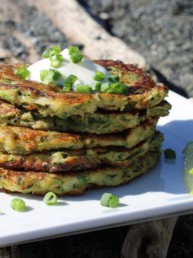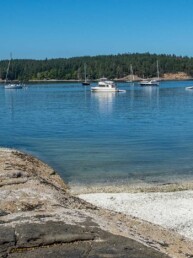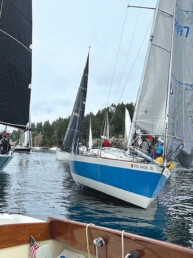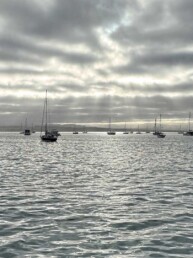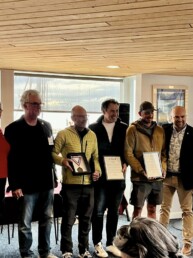A several month cruise through British Columbia gives a couple a chance to celebrate their recent marriage, experience their new home waters, and grow a shipboard sourdough starter.
The following article originally appeared in the May 2022 issue of 48° North.
I trundled out of our berth to make some breakfast and, when shuffling past the basket where we kept our produce, I saw it. It was finally going! Going so well it had overflowed and started to ooze onto the other items in the basket. My excitement was briefly eclipsed by frustration at the mess I had to clean up, but this was it. This was the day we could finally make bread with the sourdough starter that we started while on our honeymoon cruising adventure in British Columbia.
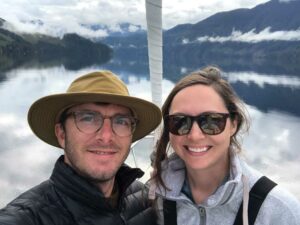 We had gotten married in June in Santa Barbara, California, and would be moving up to Vancouver, British Columbia, for my husband’s new job in November. We hadn’t planned a honeymoon before our wedding, but afterwards, found ourselves with enough time to plan and execute an epic adventure. It would be fun to sail somewhere for our honeymoon, where could we do that? Why not in beautiful British Columbia? What better way to get to know our new home?
We had gotten married in June in Santa Barbara, California, and would be moving up to Vancouver, British Columbia, for my husband’s new job in November. We hadn’t planned a honeymoon before our wedding, but afterwards, found ourselves with enough time to plan and execute an epic adventure. It would be fun to sail somewhere for our honeymoon, where could we do that? Why not in beautiful British Columbia? What better way to get to know our new home?
Instead of doing a charter, we decided to buy a sailboat that we could keep in Vancouver. We found a dark-hulled J/40 in Anacortes, Washington, that would do the trick and the sale of the boat went through at the end of August. After visiting family for a few weeks in September, we were ready to provision the boat — which we had rechristened Velella — and set out.
While I had grown up sailing and racing, I had never done any long-term cruising. Before this trip, the longest I had been on a boat without an opportunity to grocery shop was four days. We were planning to be on the boat for 45 days. Albeit, we would have the opportunity to shop multiple times during our trip, but the timing of those stops and the availability of supplies at the store were unknown. I read a lot of provisioning blogs from other cruisers, and made three trips to the grocery store with full carts and loaded up Velella.
Throughout the entire provisioning process, the one and only thing I was confident in was the fact that we could make our own bread. I bought flour and yeast and we made several delicious loaves of bread, slightly burnt on the bottom, but they were not sourdough. My husband and I both love sourdough and, several years ago, he gave me bread making supplies in the hopes that I would create a sourdough starter and supply us with delicious bread all the time. I always found excuses to not do it. Primarily, the time and schedule required to maintain it did not seem attainable while working full-time and having an active social life. Now that the two of us were on a boat with no jobs and no friends, there was nothing I could do but say “yes” when my husband suggested that we make a sourdough starter.
Our general plan was to sail quickly north to the Broughton Archipelago and spend the most time exploring islands and inlets up there before making our way down through Desolation Sound on our way back to Vancouver. A few days into our trip, we had made it quickly through the San Juan Islands and cleared Canadian customs in Poets Cove before heading up through the Gulf Islands. We anchored for a night in Madrona Bay, just east of Ganges Harbour on Salt Spring Island. It was a gray day and raining off and on, which was the weather we expected for most of the trip. We geared up and took the dinghy over to Ganges to pick up a few supplies, including the flour we needed for the starter. Sourdough starters are made from incredibly basic ingredients: whole wheat flour, water, and, as we soon found out, varying amounts of time.
As I diligently fed our starter morning and evening with carefully measured flour and water, we made our way up through the Gulf Islands and Johnstone Strait. Massive tidal changes and rapids were not things my husband and I had grown up with. We both grew up lake sailing (me on Lake Champlain and him on Lake Huron) and had spent our most recent sailing years in Santa Barbara. We used to talk about the current in Santa Barbara when racing J/24s, but it was nowhere close to the amount of current we experienced when navigating through the Inside Passage to the Broughtons and back. We had equipped ourselves with the necessary tools (Ports and Passes and Navionics) to make sure we were passing through safely at, or near, slack water. Some aspects of transiting these passages and rapids we weren’t as prepared for: we had to dodge numerous logs and large amounts and debris that got caught in these areas, and, when passing through Surge Narrows on the way north and later as we approached Dent Rapids on the way back down, we were pleasantly surprised by Dall’s porpoises zipping around us in the rapids.
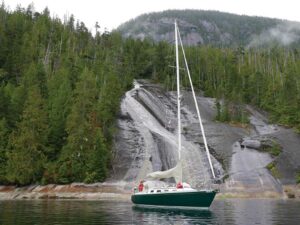
Every night, when it was time for our starter’s feeding, I had to discard half of it before adding more flour and water. I would usually do this overboard and, given the short fall days, it was always well after sunset. Some nights, I would be surprised by bioluminescence when the starter discard plopped into the water. Some of the brightest bioluminescence we saw was in Waddington Bay on Bonwick Island, which was the calmest anchorage we dropped the hook in. The glassy water mirrored the island and sky so perfectly you could not tell which way was up and which was down in a photo.
Fortunately, the dreary weather we had been expecting cleared for some gloriously sunny days that made us forget that it was nearing mid-October. As we ducked into different inlets and secluded anchorages, we didn’t come across any other cruisers. I couldn’t believe we were the only ones. We popped into Pierre’s at Echo Bay on Gilford Island to refuel and the shelves in the store were empty, as he wasn’t expecting any cruisers until next season.
While we enjoyed having the Broughton Islands to ourselves, we waited weeks for our starter to get “started.” It was well beyond the seven days that the instructions from King Arthur Baking Co. advised it would take. With feedings twice a day, I was up to my eyeballs in flour and sick of dealing with doughy goo that was not yet producing anything useful. I had almost given up on it. We even came up with, and started executing, an alternative plan: on our way north, we had kindly been given some sourdough starter from Nancy’s Bakery in Lund, just in case ours was unsuccessful, and we started using it to make bread. While I was excited to finally be eating sourdough, I was disappointed it wasn’t ours.
There are a few things that I say, jokingly, finally got our starter going. First, the baker at Nancy’s told us that they feed one of their starters with local beer from Powell River, so one night I gave our starter a little sip of beer — couldn’t hurt, right? Second, I speculated that our starter became jealous of the starter from Nancy’s. My frustration with goo was at its maximum, I had begun to neglect our starter, instead of the twice daily feedings, it was only getting one. There was the possibility that we would even give up on it entirely. Finally, our drunk, jealous starter decided it was time to get to work.
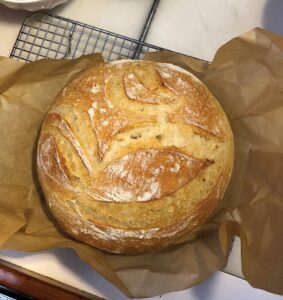
More realistically, the delay was probably caused by the lack of ideal temperatures on our boat. Cruising in the PNW in October is, in fact, quite chilly, especially at night when we turned off the heat and the engine wasn’t running. The recipe we followed indicated that the starter be kept at “warm
room temperature (70 degrees).” I was wearing two layers of fleece pants every day — the boat was nowhere near 70 degrees. I would try and find warmer spots to put it during the day: in front of a heat vent or on top of the engine compartment if the engine was running. I’m honestly surprised it even started working at all.
I was gloriously excited to make my first loaf of sourdough bread from our starter and it turned out pretty well considering the lack of ideal proofing temperatures, our lack of experience with sourdough, and the fact that we were baking in a boat oven that didn’t have ideal heat distribution. The latter resulted in nearly every loaf of bread being slightly burnt on the bottom and not quite as golden brown as we would like on top. But we were finally baking our own sailor’s sourdough!
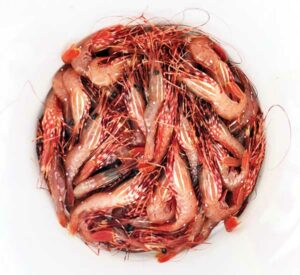
We made our way back down Johnstone Strait with much improved log-dodging skills and tucked into, once again, gloriously empty anchorages in Desolation Sound. We met up with a friend of ours in Teakerne Arm on West Redonda Island and rafted our boats in front of the waterfall, which was raging from recent rain. We caught and cooked shrimp and enjoyed sharing our sourdough bread with our friend and even passed along Nancy’s sourdough starter to him, as we no longer needed it.
Within a few days of leaving our friend and Desolation Sound, we had tucked Velella safely into her new berth in Point Roberts Marina. We moved into our apartment in Vancouver and our sourdough starter came with us. By this time, we had given her a name (Audrey II after the carnivorous plant in Little Shop of Horrors that was constantly begging “Feed me, Seymour!”) and I had gotten well into the swing of my sourdough routine. Baking bread every week or two fit easily into my land life, more seamlessly than I expected before beginning this endeavor. Being back on shore certainly made aspects of sourdough baking easier, but Audrey II’s heart will always belong somewhere between the Broughton Islands and Desolation Sound.
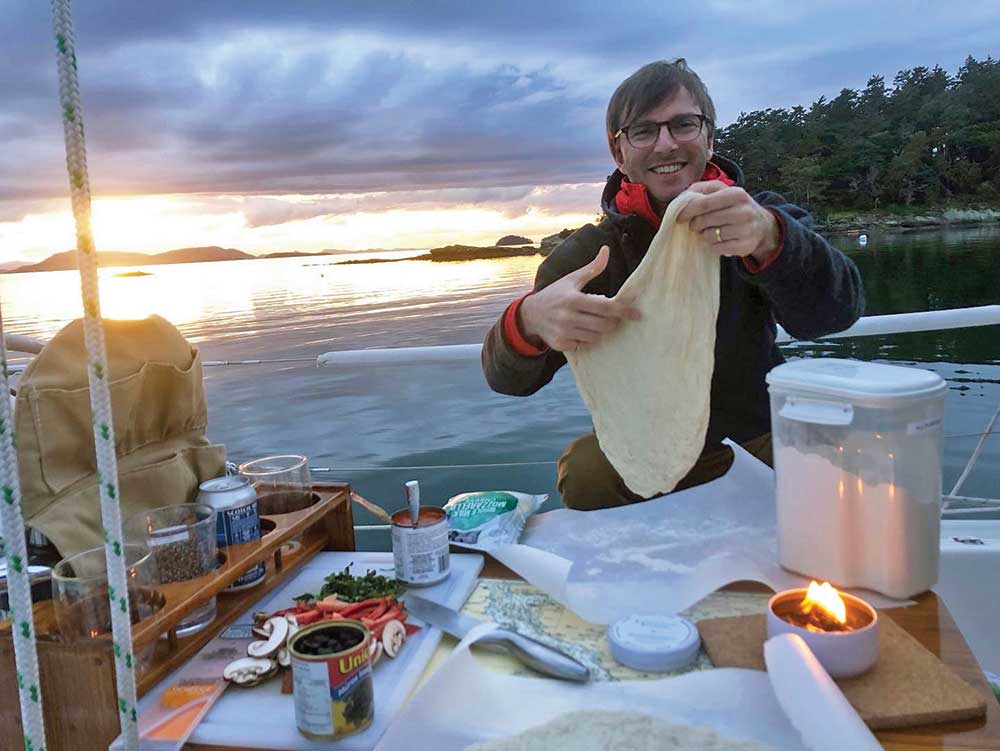
A Sailor’s Tips for Shipboard Sourdough Pizza
Audrey II has since celebrated two birthdays and accompanies us in some shape or form on almost all of our sailing trips. For baking on Velella, our favorite form that she takes is sourdough pizza crust. While making pizza on a boat may sound difficult, we have found it to be one of the most fun and, dare I say, practical things to cook while cruising. Here are some of our tips for successful on-board pizza making:
Choose pizza toppings that are canned or jarred. If you’re going on a longer trip or don’t have consistent refrigeration, some of our favorite shelf-stable toppings are: olives, artichoke hearts, roasted red peppers, capers, mushrooms, and pineapple.
Buy small 8oz cans of pizza or tomato sauce. Unless you plan on making pizza every night for a week, make sure to get small cans of sauce, which are usually enough for three to four 12-inch pizzas, depending on how much sauce you like. If you can’t find pizza-specific sauce, plain tomato sauce with some Italian seasoning dumped in works just fine. Pesto is also another great option if you want to mix it up.
Buy pre-shredded mozzarella or a pizza cheese blend. Two simple reasons for this: shredding lots of cheese by hand is not fun, and the expiration date for pre-shredded cheese is often months from purchase date.
Invest in a small pizza stone. This was a game changer in our small Force10 oven. It helps massively with heat distribution since the heat sources in the oven are just a broiler and a small burner in the center on the bottom. We leave it in all the time, no need to take it out when you are cooking other things.
Get it HOT HOT HOT. Preheat the heck out of the oven. Turn the broiler and the regular baking burner on full blast for 20 mins or so to get things good and toasty. An extra hot stone will help get a crispy bottom on your pizza. Make sure to turn the broiler off right after putting your pizza in the oven to avoid scorching the top.
Parchment paper is your friend. An absolute must in my opinion. You form and bake the pizza on the paper which saves you from making a big floury mess and also gives you something to grab to pull the pizza out of the oven.
Practice your technique for sliding the pizza into the oven before actually attempting it in the oven. Since space is limited on a boat, we don’t have a pizza peel (the big paddle thing that pizza-makers use), which makes putting the pizza in and taking it out of the oven a bit more challenging. I use a wooden cutting board as my pizza peel, which works reasonably well.
Lauren Upham
Lauren Upham and her husband, Ches, call Vancouver, BC, home. They cruise frequently on their J/40 Velella, mostly around the San Juan and Gulf Islands.

